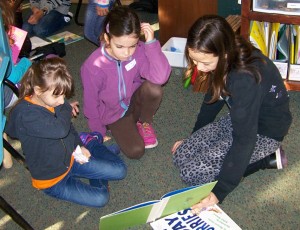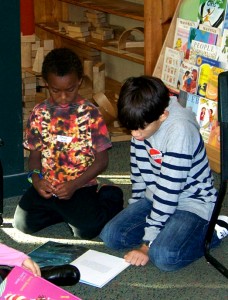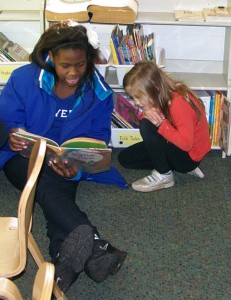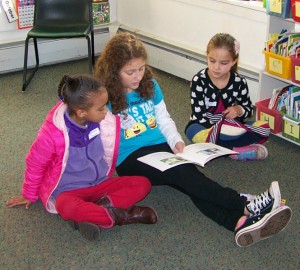Looks like a theme — reading in 3 contexts . . .
We finally found a time in which we could get together with our first grade reading buddies. In truth, we won’t just read together. We’ll play games, do some math activities, perhaps have a block-building day or two, and more. But this first meeting was all about books. Some of our class brought in favorite titles from home, I lent out three of my beloved childhood books, and there were stacks and stacks of interesting reading materials in Rich and Elisa’s classroom. It was a delightful way to spend the first part of Thursday morning. Before we went to their classroom, we had a discussion about reading with younger children. Our students shared lots of advice — let them interrupt the story with comments and questions, be sure they can see the text and the pictures while you read to them, let them read to you, be sure to read with expression, and make sure they are interested in the story or choose a different one.
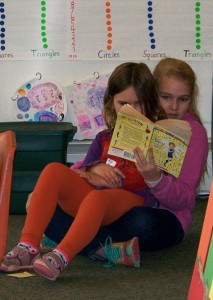
We started book groups this week. Students were given lots of titles to choose from, and we used their preferences to organize 3 groups: one reading Un Lun Dun with Amy (our librarian), one reading Truckers with Jeri, and the third group reading Because of Mr. Terupt with me. The groups will meet weekly to discuss the story and characters, make predictions, and use the “Notice and Note” strategies to think about the stories more deeply. This approach comes from a book of the same name. Essentially, it points out 6 different “signposts” that writers often employ to engage the reader more deeply. For example, a signpost called “An Aha! Moment” is one in which a character has a sudden insight about something. This should prompt the reader to stop and think about that realization and consider how this might change things. We hope that focusing on our books through this lens will enable students to slow down a bit and do more thinking as they read, especially those who tend to zoom along on the action of the plot. A copy of the full set of signposts is here: The-Notice-and-Note-Signposts . We introduced this metacognitive element by sharing that page with students. Then we read and discussed “Thank you, Ma’am” — a short story by Langston Hughes that contains many contrasts and contradictions (one of the signposts). Finally we asked students to think back over stories and films they enjoyed and try to come up with an example of each of the signposts from those sources. Although not everyone came up with examples of all six categories, they were mostly able to identify at least four.
Something that we have been working on with everyone is improving the appearance, accuracy, and completeness of their work throughout the day. One important element is reading the directions. Our constant litany is that we need to read the directions and/or question at least twice: once before we start, and once when we think we are finished. Some students skip over the directions entirely. Some get so absorbed in a problem or response that they forget there was a second part to the work or that the answer had to be given in a particular form. Reading the directions or the question after as well as before will prevent that much of the time. We’re also working on how students organize their handwritten work on the page. Start at the top left. Leave some space between responses instead of separating them with frames. Pay attention to the margins of the paper. Choose appropriate paper for the work — do you need plain paper, lined paper, or graph paper? Number your responses to match the worksheet or textbook page. This is needed not only for mathematics work but also for other kinds of writing. Making it easy for someone to read and understand what you have written is always a good idea.
Friday ended with our traditional Halloween celebration. It was a delightful way to wrap up the week. Thanks to all of the family members who were able to join us for the afternoon.

